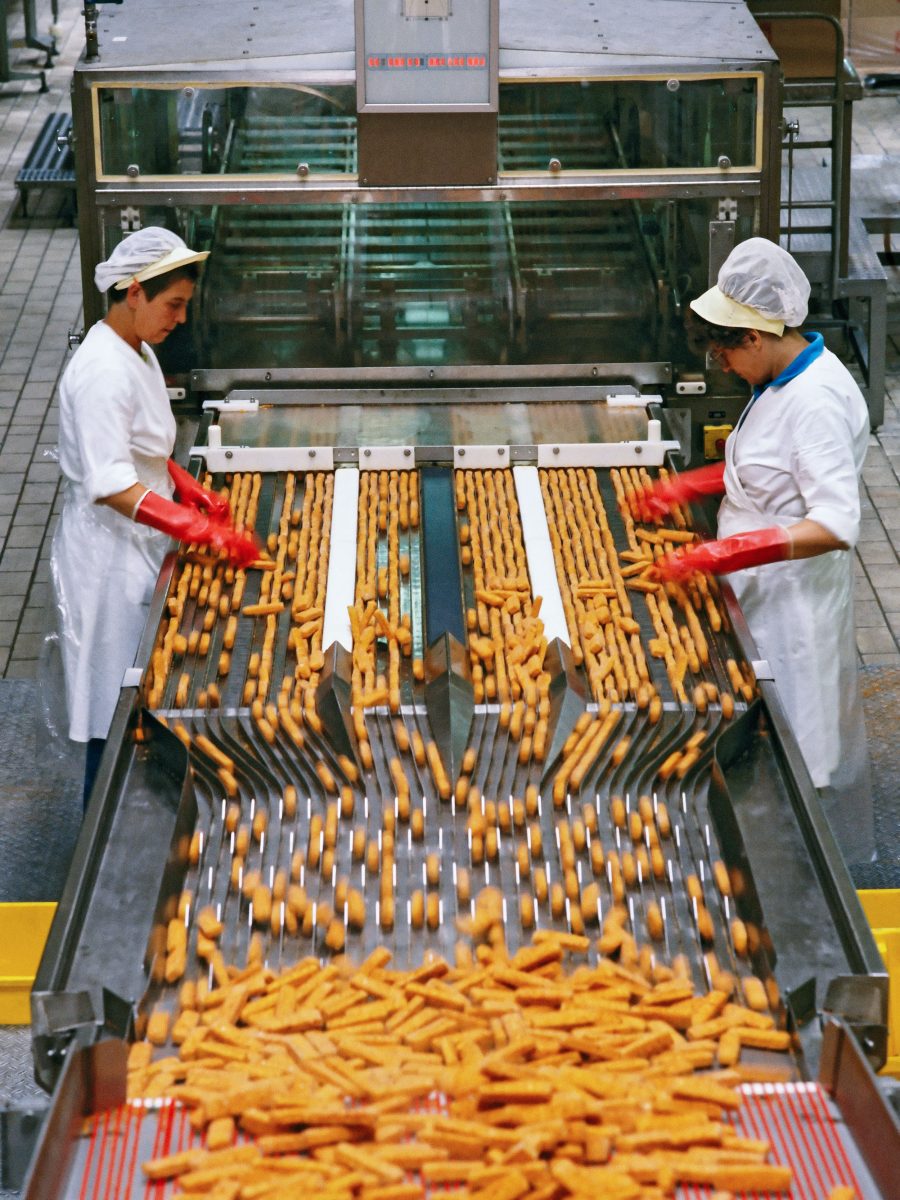2021年05月11日 08:00
NHK BS1 【キャッチ!世界のトップニュース】
[<ワールドEYES>ロシア・極東の漁業・新型コロナで窮地]
ロシアで水揚げされる魚の半数以上を占める豊かな漁場を抱えるロシア極東。
なかでもスケソウダラの水揚げ量は世界第1位。
しかし新型コロナウイルスの感染拡大の影響で最大の輸出先だった中国が輸入を制限。
水揚げされた大量の魚が行き場を失っている。漁業関係者はどう切り抜けるのか?
苦境に立つ漁業の現状について現地から高塚奈緒NHKウラジオストク支局長が伝えた。
日本海やオホーツク海を始め豊かな漁場を抱えるロシア極東。
漁業は基幹産業の1つ。
主力はスケソウダラで世界1位の水揚げ量を誇る。
倉庫には中国向けのスケソウダラが高く積み上げられている。
スケソウダラは水揚げ後、ほとんどの場合、洋上で頭部と内臓を取り除き冷凍。
7割が中国へ運ばれ中国の工場で加工され主にヨーロッパに輸出される。
しかし新型コロナウイルス感染拡大で輸入品の検疫を強化。
現在ほぼすべての魚の受け入れを停止。
漁業組合代表・オリガブルコワは今こそ中国依存の漁業から脱却すべきだと考えている。
北海道機船漁業協同組合連合会・原口聖二常務理事がコメント。
ロシア政府は2030年までに達成する漁業発展戦略を掲げ、地域経済を守ろうとしている。
映像提供・Dobroflot。(中継)ウラジオストク。
The Unlikely Success of Fish Sticks
From unappetizing “fishbricks” to cultural darlings, the 1950s convenience food has enjoyed a winning streak—no less so than during the COVID-19 pandemic.

by Ute Eberle April 23, 2021
There are many curious facts about fish sticks. The invention of this frozen food warranted a US patent number, for instance: US2724651A. The record number of them stacked into a tower is 74. And, every year, a factory in Germany reportedly produces enough fish sticks to circle the Earth four times.
But the most peculiar thing about fish sticks may be their mere existence. They debuted on October 2, 1953, when General Foods released them under the Birds Eye label. The breaded curiosities were part of a lineup of newly introduced rectangular foods, which included chicken sticks, ham sticks, veal sticks, eggplant sticks, and dried lima bean sticks. Only the fish stick survived. More than that, it thrived. In a world in which many people are wary of seafood, the fish stick spread even behind the Iron Curtain of the Cold War.
Beloved by some, merely tolerated by others, the fish stick became ubiquitous—as much an inevitable food rite of passage for kids as a cultural icon. There’s an entire South Park episode devoted to riffing off the term fish stick, and the artist Banksy featured the food in a 2008 exhibit. When Queen Elizabeth II celebrated her 90th birthday in 2016, Birds Eye presented her with a sandwich valued at US $257 that included blanched asparagus, saffron mayonnaise, edible flowers, caviar, and—most prominently—gold leaf–encrusted fish sticks.

A British advertisement for Smedley’s fish sticks appears in 1957, four years after the frozen food was unveiled by Birds Eye. Photo by Neil Baylis/Alamy Stock Photo
To explain why the fish stick became successful, there’s probably no better guide than Paul Josephson, the self-described “Mr. Fish Stick.” Josephson teaches Russian and Soviet history at Colby College in Maine, but his research interests are wide ranging (think sports bras, aluminum cans, and speed bumps). In 2008, he penned what is still the defining scholarly paper on fish sticks. That research required him to get information from seafood companies, which proved unexpectedly challenging. “In some ways, it was easier to get into Soviet archives having to do with nuclear bombs,” he recalls.
Josephson dislikes fish sticks. Even as a kid, he didn’t understand why they were so popular. “I found them dry,” he says. Putting aside personal preference, Josephson insists that the world didn’t ask for fish sticks. “No one ever demanded them.”
Instead, the fish stick solved a problem that had been created by technology: too much fish. Stronger diesel engines, bigger boats, and new materials increased catches after the Second World War. Fishers began scooping up more fish than ever before, says Josephson. To keep them from spoiling, fish were skinned, gutted, deboned, and frozen on board.
Frozen food, however, had a terrible reputation. Early freezers chilled meat and vegetables slowly, causing the formation of large ice crystals that turned food mushy upon defrosting.
That all changed in the 1920s, when entrepreneur Clarence Birdseye developed a novel freezing technique, in which food was placed between metal plates chilled to at least -30 °C. Food froze so quickly that the dreaded ice crystals couldn’t form. But when used on fish, the method created large blocks of intermingled fillets that, when pried apart, tore into “mangled, unappetizing chunks,” wrote Josephson. The fishing industry tried selling the blocks whole, as fishbricks. These were packaged like blocks of ice cream, with the idea that a housewife could chop off however much fish she wanted that day. But supermarkets had little luck selling the unwieldy bricks, and many stores even lacked adequate freezer space to display them.
Success came when the bricks were cut into standardized sticks. In a process that has remained essentially unchanged, factories run the frozen fish blocks through an X-ray machine to ensure they’re bone-free, then use bandsaws to cut them into slices. These “fingers” are dumped into a batter of egg, flour, salt, and spices, and then breaded. Afterward, they’re briefly tossed into hot oil to set the coating. The whole process takes about 20 minutes, during which the fish remains frozen, even when dunked in the deep fryer.

Production line workers inspect fish sticks as they speed down a conveyor belt. The process of slicing, battering, and frying the frozen food has remained virtually unchanged since the 1950s. Photo by RGB Ventures/SuperStock/Alamy Stock Photo
In 1953, 13 companies produced 3.4 million kilograms of fish sticks. A year later, four million kilograms were produced by another 55 companies. This surge in popularity was partly due to a marketing push that stressed the convenience of the new food: “no bones, no waste, no smell, no fuss,” as one Birds Eye advertisement proclaimed.
The appeal of fish sticks is somewhat paradoxical. They contain fish, but only that with the mildest flavor—and that fish has been dressed up to resemble chicken tenders.
The battered disguise may be needed because, at least in North America, seafood has often been second-tier. “We’ve mostly considered the eating of fish to be beneath our aspirations,” writes chef and author Barton Seaver in American Seafood. Traditionally, fish was associated with sacrifice and penance—food to eat when meat was unaffordable or, if you were Catholic, to eat on the many days when red meat is verboten. Fish also spoils fast, smells bad, and contains sharp bones that pose a choking hazard.
The advent of fish sticks made eating fish easier and more palatable for the seafood wary. “You can almost pretend that it isn’t fish,” says Ingo Heidbrink, a maritime historian at Old Dominion University in Virginia. In his native Germany, where a reported seven million people eat fish sticks at least once a week, companies changed the fish at least three times since its introduction, from cod to pollock to Alaska pollock, a distinct species. “Consumers didn’t seem to notice,” says Heidbrink.
A 1964 advertisement for Birds Eye fish fingers, as the battered convenience food is known in the United Kingdom.
Josephson calls fish sticks “the ocean’s hot dogs.” Served as casseroles or alongside mashed potatoes, they quickly became standby meals for school lunches and family dinners. During the pandemic, demand has risen—in some countries reportedly by up to 50 percent—as families stock up on convenience foods during lockdowns.
Surprisingly, fish sticks are fairly sustainable. Today, most contain Alaska pollock, which is largely sourced from well-managed fisheries, says Jack Clarke, a sustainable seafood advocate at the United Kingdom–based Marine Conservation Society. The climate impact of fish sticks is small, too. “I was surprised at how low it was,” says Brandi McKuin, a postdoctoral researcher at the University of California, Santa Cruz, who recently studied Alaska pollock products. Each kilogram of fish sticks produces about 1.3 kilograms of carbon dioxide, which “rivals the climate impact of tofu,” she says. Beef, by comparison, produces over 100 times that amount of carbon dioxide per kilogram.
But not everyone seems confident about what exactly they’re eating when they consume the breaded fish. In the United Kingdom, where fish sticks are known as fish fingers, a survey revealed that one in five young adults believes they are actually the fingers of fish.
They still eat them happily.


















